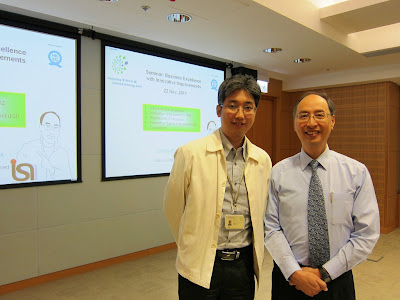The term "innovation" might mean different things to different people. In business term, innovation is turning the new concept into commercial success or widespread use. The seminar entitled "Business Excellence with Innovative Improvements" was organized by Hong Kong Science and Technology Parks Corporation (HKSTPC) and supported by Hong Kong Society for Quality (HKSQ) on 22nd November 2011. It aimed to introduce the comprehensive framework of innovation for organization, from cultural concern, to strategy and leadership.
Dr. Victor Lo (Vice Chairman - Institute of Systematic Innovation, HK) is an expert in innovation and quality management. He introduced the Institute of Systematic Innovation, HK (ISI-HK) is non-profit making organization and officially established in Jan, 2011.

In the beginning, Dr. Lo briefed different innovation product and thinking for participants' rehearsal. He quoted "The Economist Magazine" that Innovation is now recognized as the single most important ingredient in any modern economy. Then he showed the innovative thinking process in business organizations and emphasized the important of "Function".

Then Dr. Lo introduced Mr. Genrich Altshuller (Father of TRIZ ) who created the Theory of Solving Inventive Problems (TRIZ in the Russian abbreviation - теория решения изобретательских задач). He reviewed 200,000 patents and discovered three key findings as follows: 1) Levels of Invention; 2) Patterns of Evolution and 3) Patterns of Invention.
There were included 39 Engineering Parameters and 40 Innovation Principles in which formed a famous table called "Contradiction Matrix". The matrix demonstrated which of the 40 principles have been used most frequently to solve a problem that involves a particular contradiction.

After the introduction of TRIZ, Dr. Lo mentioned the Five TRIZ Pillars which supported Innovation Quality Improvement (IQI). The Five TRIZ Pillars are explained below:
1. Functionality (Customer buy not products nor services, but Functions!)
2. Resources (Limitation of resources need innovation.)
3. Ideality (It defines as "All Useful Functions" / "All Harmful Functions")
4. Contradiction (It separates Physical and Technical Contradiction)
5. Evolution (Evolution has limited and then need to have breakthrough innovation.)
A easy way to remember the Five Pillars is "Fry RICE".

Dr. Lo used different toothbrush (Its function is cleaning) as an example to explain Evolution.

Based on Altshuller's TRIZ level of innovation, five levels are identified. Dr. Lo would like to use the first four level to cover most of people in the organization to achieve Innovative Total Improvement.

Moreover, Dr. Lo quoted 2 of Deming's 14 points to assist the innovation system development.
1. Create constancy of purpose toward improvement of product and service, with the aim to become competitive and to stay in business, and to provide jobs.
2. Adopt the new philosophy. Management must awaken to the challenge, must learn their responsibilities, and take on leadership for change.
Then the solution by innovation approach was stated as the diagram below.

Innovative Quality Improvement Framework included "Culture Aspect", "Strategy & Leadership", "Innovation Training" and "Innovation Management System" were mentioned.

Originally, TRIZ is mainly for technical system, engineers, technical problem solving and individual. Dr. Lo proposed TRIZ based Innovative Quality Improvement which used for all disciplines, all level of people, any system and covering entire organization.

Q&A session. (One of HKSQ members discussed with Dr. Lo.)

I took a photo with Dr. Lo after the seminar.

Reference:
My previous articles:
Innovation / Creativity Management (BS 7000-1:2008) - http://qualityalchemist.blogspot.com/2009/06/innovation-creativity-management-bs.html
HKU Quality Management Student Forum - http://qualityalchemist.blogspot.com/2011/04/hku-quality-management-student-forum.html
Innovation – From Art to Science - http://qualityalchemist.blogspot.com/2009/08/innovation-from-art-to-science.html
沒有留言:
發佈留言